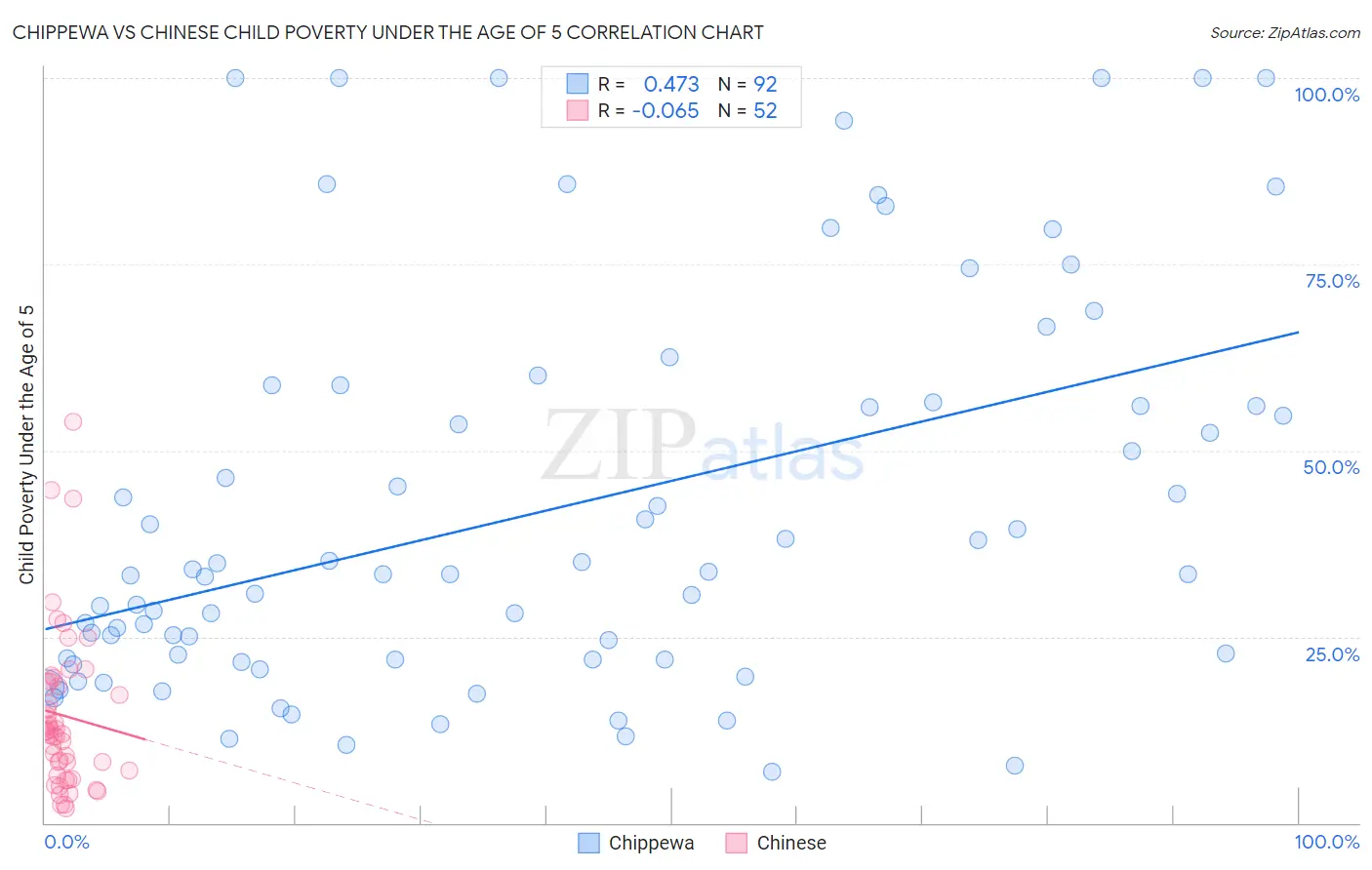Chippewa vs Chinese Child Poverty Under the Age of 5
COMPARE
Chippewa
Chinese
Child Poverty Under the Age of 5
Child Poverty Under the Age of 5 Comparison
Chippewa
Chinese
23.4%
CHILD POVERTY UNDER THE AGE OF 5
0.0/ 100
METRIC RATING
319th/ 347
METRIC RANK
13.1%
CHILD POVERTY UNDER THE AGE OF 5
100.0/ 100
METRIC RATING
7th/ 347
METRIC RANK
Chippewa vs Chinese Child Poverty Under the Age of 5 Correlation Chart
The statistical analysis conducted on geographies consisting of 210,183,643 people shows a moderate positive correlation between the proportion of Chippewa and poverty level among children under the age of 5 in the United States with a correlation coefficient (R) of 0.473 and weighted average of 23.4%. Similarly, the statistical analysis conducted on geographies consisting of 64,186,861 people shows a slight negative correlation between the proportion of Chinese and poverty level among children under the age of 5 in the United States with a correlation coefficient (R) of -0.065 and weighted average of 13.1%, a difference of 79.2%.

Child Poverty Under the Age of 5 Correlation Summary
| Measurement | Chippewa | Chinese |
| Minimum | 6.9% | 1.9% |
| Maximum | 100.0% | 53.8% |
| Range | 93.1% | 52.0% |
| Mean | 42.0% | 14.4% |
| Median | 33.3% | 12.1% |
| Interquartile 25% (IQ1) | 22.0% | 6.7% |
| Interquartile 75% (IQ3) | 56.2% | 18.8% |
| Interquartile Range (IQR) | 34.2% | 12.1% |
| Standard Deviation (Sample) | 26.2% | 10.8% |
| Standard Deviation (Population) | 26.0% | 10.7% |
Similar Demographics by Child Poverty Under the Age of 5
Demographics Similar to Chippewa by Child Poverty Under the Age of 5
In terms of child poverty under the age of 5, the demographic groups most similar to Chippewa are Choctaw (23.5%, a difference of 0.38%), Immigrants from Honduras (23.5%, a difference of 0.41%), Dutch West Indian (23.3%, a difference of 0.48%), Menominee (23.3%, a difference of 0.58%), and Ute (23.5%, a difference of 0.64%).
| Demographics | Rating | Rank | Child Poverty Under the Age of 5 |
| Hondurans | 0.0 /100 | #312 | Tragic 23.0% |
| Bahamians | 0.0 /100 | #313 | Tragic 23.0% |
| U.S. Virgin Islanders | 0.0 /100 | #314 | Tragic 23.0% |
| Arapaho | 0.0 /100 | #315 | Tragic 23.1% |
| Yakama | 0.0 /100 | #316 | Tragic 23.1% |
| Menominee | 0.0 /100 | #317 | Tragic 23.3% |
| Dutch West Indians | 0.0 /100 | #318 | Tragic 23.3% |
| Chippewa | 0.0 /100 | #319 | Tragic 23.4% |
| Choctaw | 0.0 /100 | #320 | Tragic 23.5% |
| Immigrants | Honduras | 0.0 /100 | #321 | Tragic 23.5% |
| Ute | 0.0 /100 | #322 | Tragic 23.5% |
| Pueblo | 0.0 /100 | #323 | Tragic 23.7% |
| Paiute | 0.0 /100 | #324 | Tragic 23.8% |
| Immigrants | Congo | 0.0 /100 | #325 | Tragic 23.9% |
| Central American Indians | 0.0 /100 | #326 | Tragic 23.9% |
Demographics Similar to Chinese by Child Poverty Under the Age of 5
In terms of child poverty under the age of 5, the demographic groups most similar to Chinese are Iranian (13.1%, a difference of 0.020%), Immigrants from Iran (13.1%, a difference of 0.17%), Immigrants from Singapore (12.9%, a difference of 0.98%), Burmese (13.2%, a difference of 1.3%), and Immigrants from Korea (13.2%, a difference of 1.4%).
| Demographics | Rating | Rank | Child Poverty Under the Age of 5 |
| Immigrants | India | 100.0 /100 | #1 | Exceptional 11.5% |
| Immigrants | Taiwan | 100.0 /100 | #2 | Exceptional 11.6% |
| Filipinos | 100.0 /100 | #3 | Exceptional 11.6% |
| Thais | 100.0 /100 | #4 | Exceptional 12.3% |
| Immigrants | Hong Kong | 100.0 /100 | #5 | Exceptional 12.4% |
| Immigrants | Singapore | 100.0 /100 | #6 | Exceptional 12.9% |
| Chinese | 100.0 /100 | #7 | Exceptional 13.1% |
| Iranians | 100.0 /100 | #8 | Exceptional 13.1% |
| Immigrants | Iran | 100.0 /100 | #9 | Exceptional 13.1% |
| Burmese | 100.0 /100 | #10 | Exceptional 13.2% |
| Immigrants | Korea | 100.0 /100 | #11 | Exceptional 13.2% |
| Immigrants | South Central Asia | 100.0 /100 | #12 | Exceptional 13.3% |
| Bhutanese | 100.0 /100 | #13 | Exceptional 13.4% |
| Okinawans | 100.0 /100 | #14 | Exceptional 13.4% |
| Indians (Asian) | 100.0 /100 | #15 | Exceptional 13.4% |